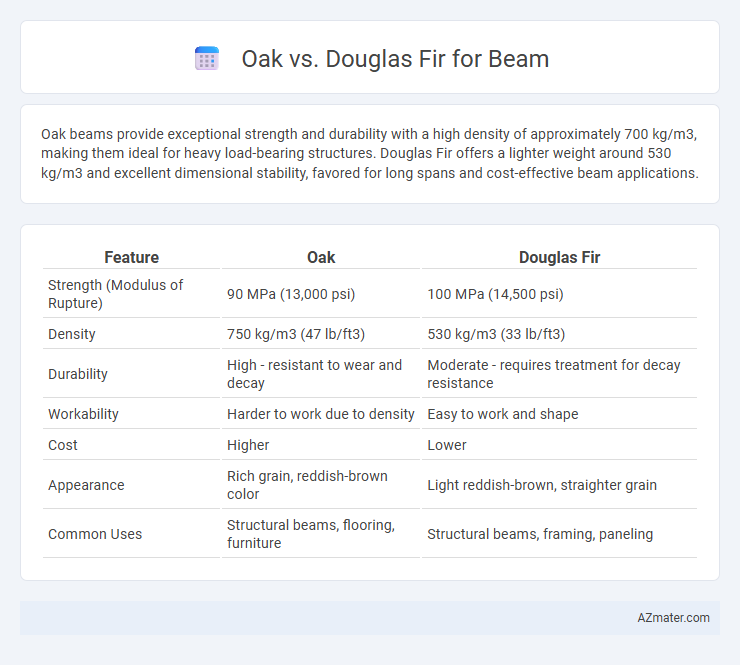Oak beams provide exceptional strength and durability with a high density of approximately 700 kg/m3, making them ideal for heavy load-bearing structures. Douglas Fir offers a lighter weight around 530 kg/m3 and excellent dimensional stability, favored for long spans and cost-effective beam applications.
Table of Comparison
| Feature | Oak | Douglas Fir |
|---|---|---|
| Strength (Modulus of Rupture) | 90 MPa (13,000 psi) | 100 MPa (14,500 psi) |
| Density | 750 kg/m3 (47 lb/ft3) | 530 kg/m3 (33 lb/ft3) |
| Durability | High - resistant to wear and decay | Moderate - requires treatment for decay resistance |
| Workability | Harder to work due to density | Easy to work and shape |
| Cost | Higher | Lower |
| Appearance | Rich grain, reddish-brown color | Light reddish-brown, straighter grain |
| Common Uses | Structural beams, flooring, furniture | Structural beams, framing, paneling |
Introduction to Oak and Douglas Fir Beams
Oak beams are renowned for their exceptional strength, durability, and natural resistance to decay, making them ideal for heavy structural applications and architectural features. Douglas Fir beams offer a high strength-to-weight ratio, superior dimensional stability, and a straight grain, which provide excellent load-bearing capabilities in construction and timber framing. Both wood types are valued in beam production, with oak excelling in longevity and aesthetic appeal, while Douglas Fir is favored for its performance and cost-effectiveness in building projects.
Wood Properties: Oak vs Douglas Fir
Oak offers exceptional hardness and durability, making it highly resistant to wear and ideal for structural beams requiring load-bearing strength. Douglas Fir features a high strength-to-weight ratio with consistent straight grain, providing excellent stiffness and stability while being lighter than oak. Both woods exhibit good resistance to compression, but oak's higher density results in greater overall strength, whereas Douglas Fir's flexibility makes it suitable for beams exposed to dynamic loads.
Strength and Structural Performance
Oak beams exhibit exceptional strength and durability due to their dense grain structure, making them ideal for heavy load-bearing applications in construction. Douglas Fir is prized for its high strength-to-weight ratio and excellent stiffness, offering superior structural performance in long spans and resist bending under stress. Both woods provide robust support, but Oak generally offers higher hardness, while Douglas Fir is more dimensionally stable and easier to work with for precise structural engineering.
Durability and Lifespan Comparison
Oak beams offer superior durability with a high resistance to wear, decay, and insect damage, making them ideal for long-lasting structural applications. Douglas Fir beams, while slightly less durable, provide excellent strength-to-weight ratio and moderate resistance to decay under proper treatment. Oak typically boasts a lifespan exceeding 50 years in outdoor or high-stress conditions, whereas Douglas Fir beams can last around 30-40 years when adequately maintained.
Aesthetic Differences and Grain Patterns
Oak beams exhibit a prominent, coarse grain with intricate, wavy patterns that create a traditional and rustic aesthetic, often showcasing warm, golden to reddish-brown hues. Douglas Fir beams feature a straighter, tighter grain with a smoother texture and lighter, more uniform color palette ranging from pale yellow to reddish-brown, lending a cleaner and more modern appearance. The distinct grain patterns and color variations between Oak and Douglas Fir significantly impact their visual impact in architectural and interior design applications.
Workability and Installation
Oak beams offer excellent workability due to their dense grain structure, allowing for precise cuts and smooth finishes, though they require specialized tools for installation because of their hardness. Douglas Fir, known for its straight grain and moderate hardness, provides easier machinability and faster installation, making it ideal for projects demanding efficiency without sacrificing strength. Choosing between Oak and Douglas Fir for beams often depends on balancing the durability and aesthetic appeal of Oak with the flexibility and ease of handling provided by Douglas Fir.
Cost Analysis: Oak vs Douglas Fir Beams
Douglas Fir beams generally cost less than Oak beams, making it a more budget-friendly option for construction projects requiring strength and durability. Oak beams, although pricier, offer superior hardness and a more attractive grain, which can justify the investment in high-end architectural applications. Cost analysis favors Douglas Fir for large-scale or cost-sensitive builds, while Oak is preferred when aesthetic appeal and long-term resilience outweigh initial expenses.
Environmental Impact and Sustainability
Oak beams, sourced from slower-growing hardwood forests, have a higher carbon sequestration potential due to their density and longevity, making them a durable and sustainable choice for long-term structural use. Douglas Fir, a fast-growing softwood, offers a lower environmental impact through rapid renewability and efficient forest management practices, often certified by organizations like FSC or SFI. Choosing between oak and Douglas Fir beams depends on balancing carbon storage benefits with sustainably managed harvesting cycles, where Douglas Fir typically enables quicker forest regeneration and habitat preservation.
Common Applications in Construction
Oak beams are widely used in residential and commercial construction for structural support due to their exceptional strength and durability, making them ideal for load-bearing frameworks and flooring systems. Douglas Fir beams are preferred in heavy timber construction, bridges, and large-scale commercial buildings because of their high strength-to-weight ratio and resistance to warping. Both woods are valued for their stability and aesthetic appeal, with Oak offering a classic, dense grain and Douglas Fir providing a lighter, more uniform texture suited for visible beams and architectural features.
Choosing the Right Beam for Your Project
Oak beams offer exceptional strength and durability, ideal for heavy structural loads and long-lasting projects, while Douglas Fir beams provide excellent dimensional stability and are more cost-effective for moderate load requirements. Consider oak for projects demanding superior hardness and resistance to wear, especially in exposed or high-traffic areas, whereas Douglas Fir suits applications needing reliable strength with easier workability. Evaluating the specific load capacity, environmental conditions, and budget will help determine the optimal beam choice for your construction needs.

Infographic: Oak vs Douglas Fir for Beam
 azmater.com
azmater.com